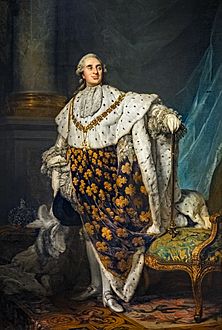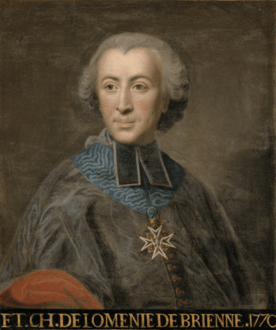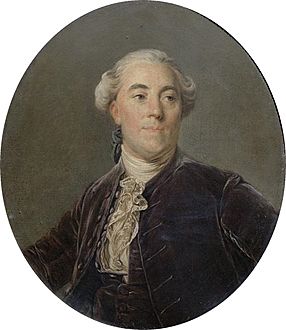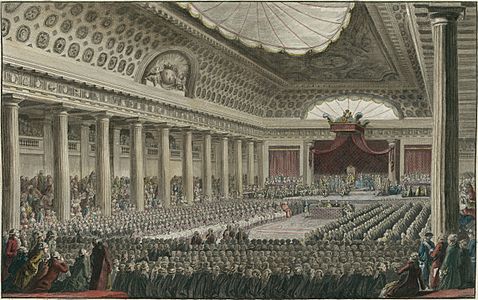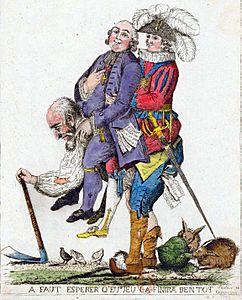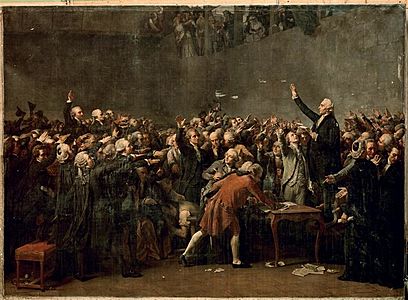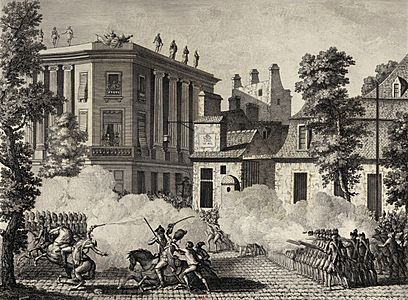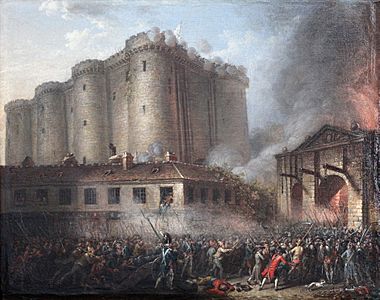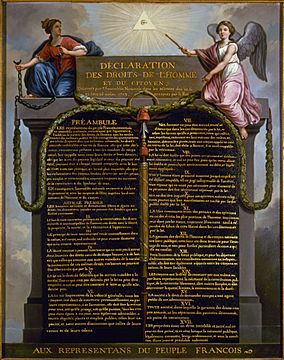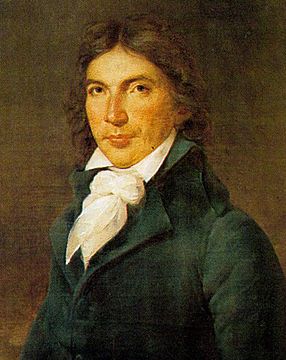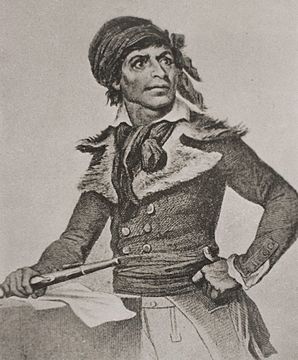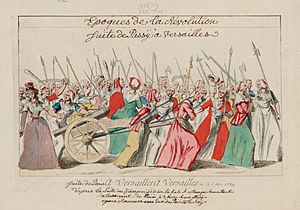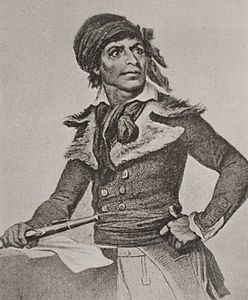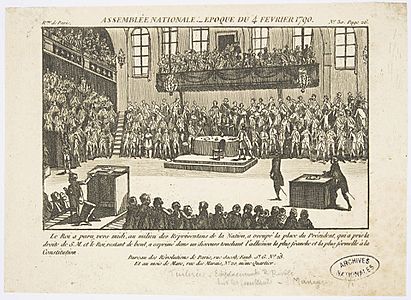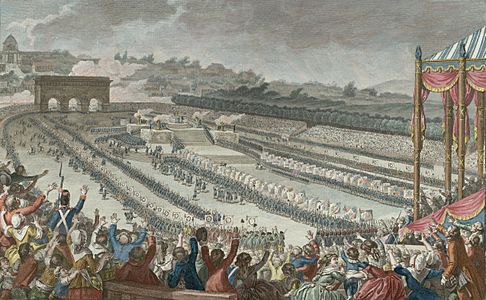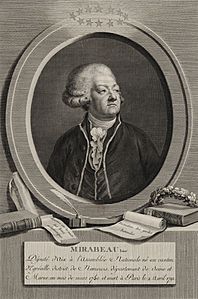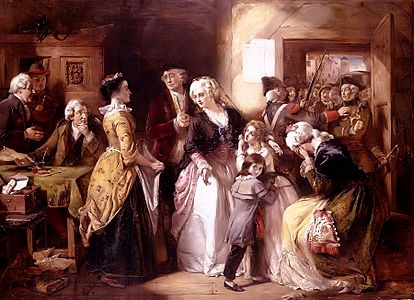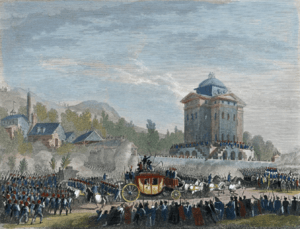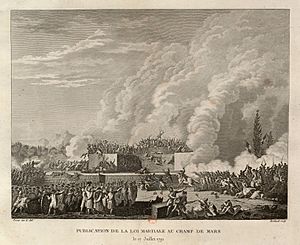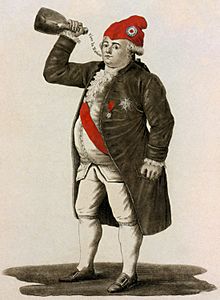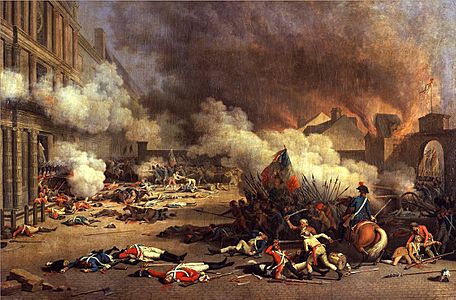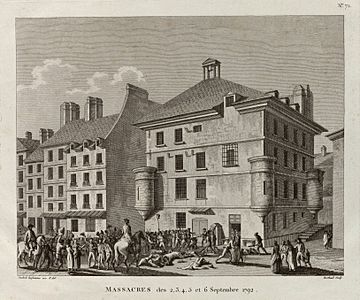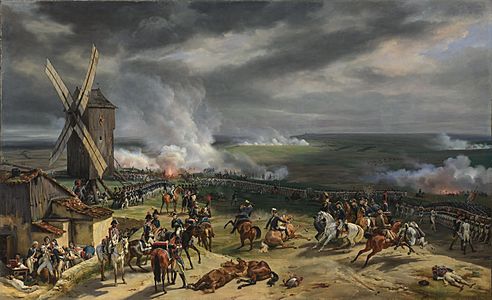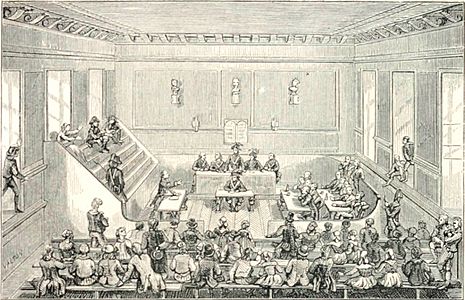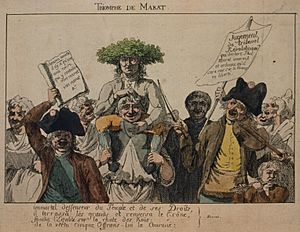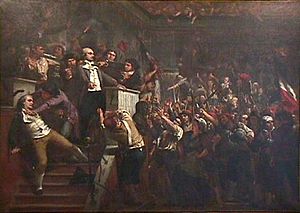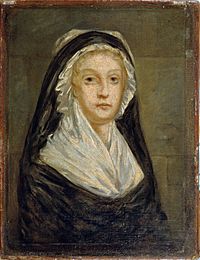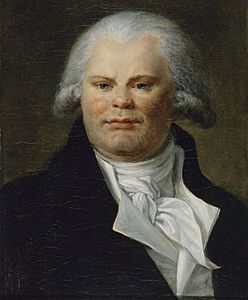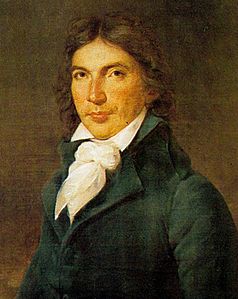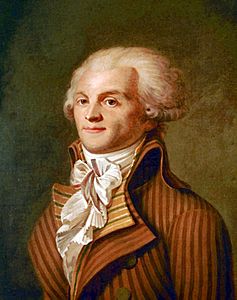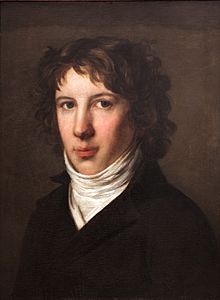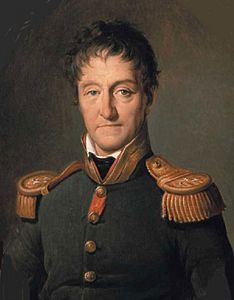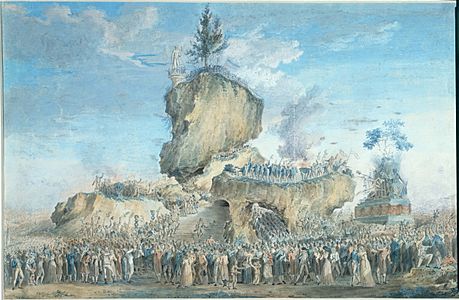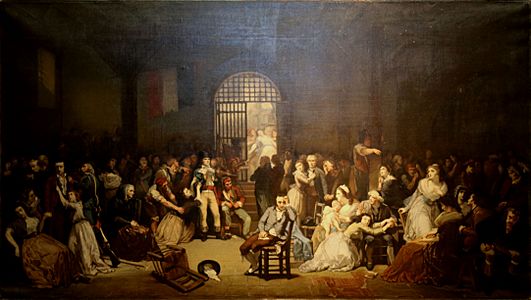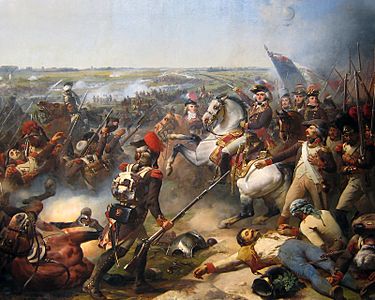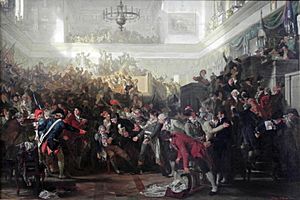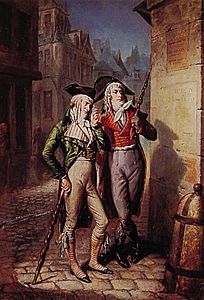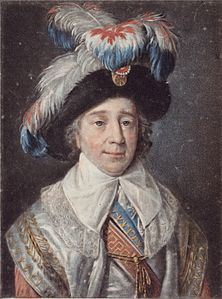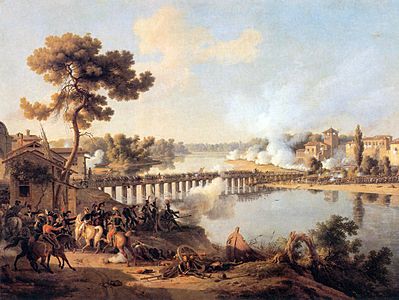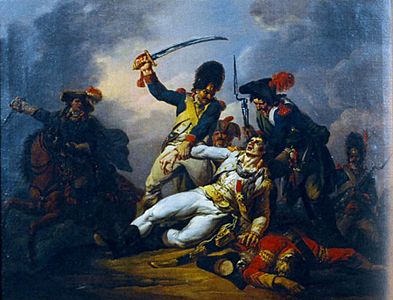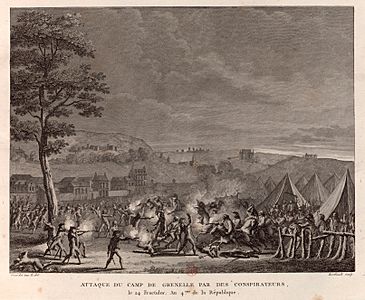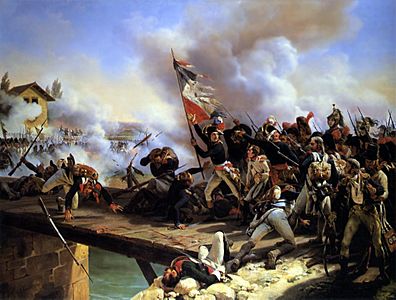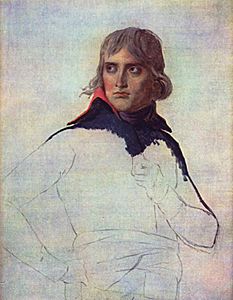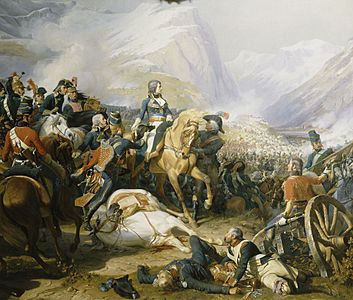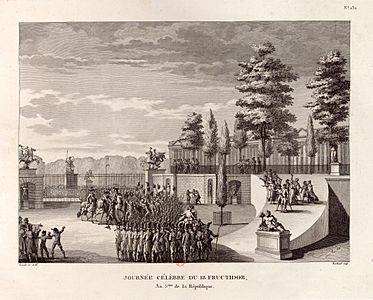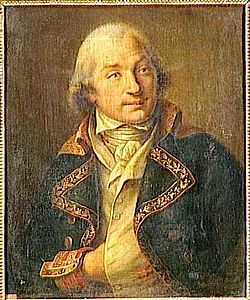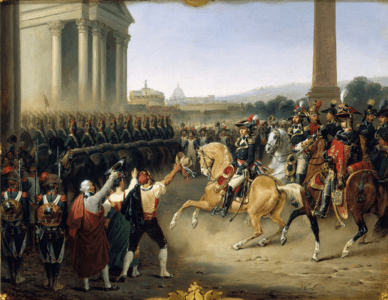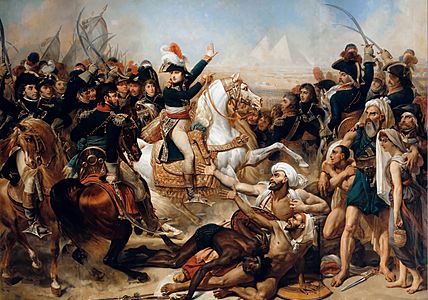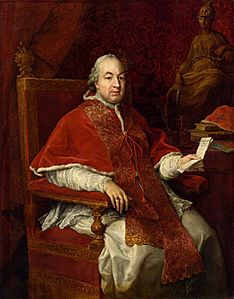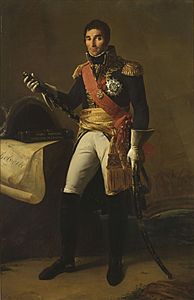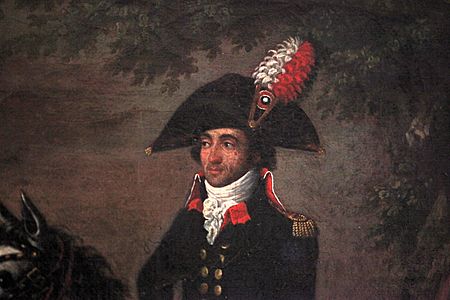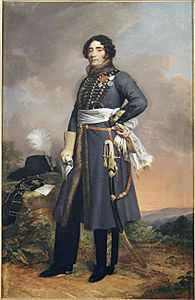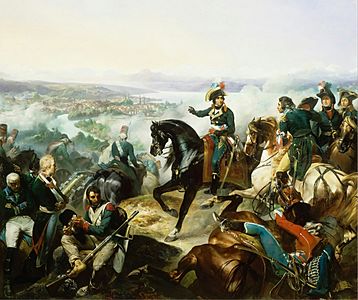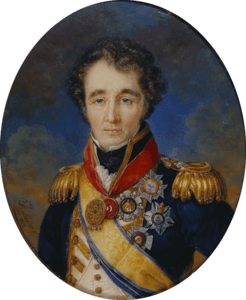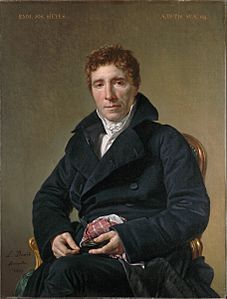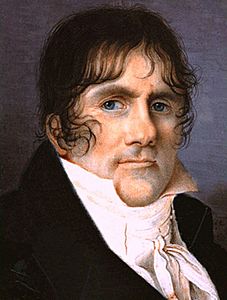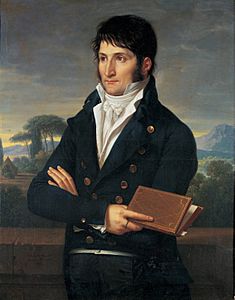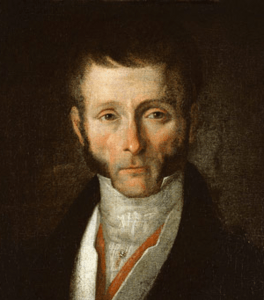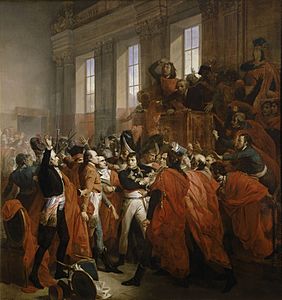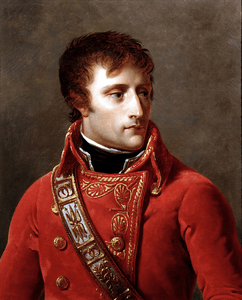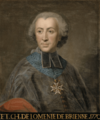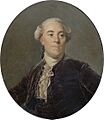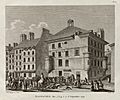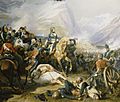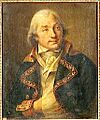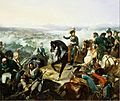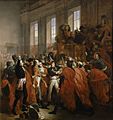Timeline of the French Revolution facts for kids
The following is a timeline of the French Revolution, rewritten for young readers.
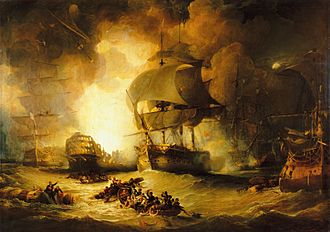
The French fleet is defeated by Admiral Nelson at the Battle of the Nile (August 1, 1798)
|
|
| Date | 1789–1799 |
|---|---|
| Location | France |
| Participants | French society |
| Outcome |
|
Contents
- 1788: France's Money Troubles Begin
- 1789: The Revolution Starts with Big Changes
- 1790: The Rise of Political Clubs
- 1791: The Royal Family Tries to Escape
- 1792: War and the End of the Monarchy
- December 10, 1792-January 21, 1793: Trial and Execution of Louis XVI
- 1793: France at War; Jacobins Take Power; The Terror Begins
- 1794: The Height of the Terror and Robespierre's Fall
- 1795: The Directory Replaces the Convention
- 1796: Napoleon's Italian Campaign; Royalists Defeated
- 1797: Bonaparte Dominates Italy; Republican Coup in Paris
- 1798: New Republics; Bonaparte Invades Egypt
- 1799: France at War; Bonaparte Returns; The Consulate Takes Power; Revolution Ends
- Images for kids
- See also
1788: France's Money Troubles Begin
-
King Louis XVI in 1777
-
Jacques Necker, finance minister 1788-90
France was in deep financial trouble. The king's treasury was empty.
- June 7: People in Grenoble started the first revolt against the king. This was called the Day of the Tiles.
- July 21: An assembly in Vizille called for a meeting of the Estates General. This was a big meeting of representatives from the nobility, clergy, and common people.
- August 8: The government officially announced it had no money. The Paris Parliament refused to help with new taxes. So, the finance minister, Brienne, set a date for the Estates General to meet on May 5, 1789. This meeting hadn't happened since 1614!
- August 16: The government stopped paying its debts.
- August 25: Brienne resigned. A popular Swiss banker, Jacques Necker, took his place. Bankers agreed to lend money to the state. But only if the Estates General could fully reform the tax system.
- December 27: Necker announced that the common people, known as the Third Estate, would have double the number of representatives. Nobles and clergy could also join them.
1789: The Revolution Starts with Big Changes
-
The Tennis Court Oath (June 20, 1789), by Couder
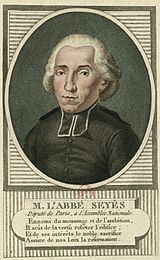
January
- January: A writer named Emmanuel Joseph Sieyès published a famous pamphlet. It asked: "What is the Third Estate? Everything. What has it been until now? Nothing. What does it demand to be? Something."
- January 24: King Louis XVI called for elections for the Estates General.
April
- April 27: Riots broke out in Paris among factory workers.
May
- May 5: The Estates General officially opened at Versailles.
- May 6: The Third Estate refused to meet separately. They invited the clergy and nobles to join them.
- May 20: The clergy gave up their special tax benefits. They agreed to pay taxes like everyone else.
- May 22: The nobility also gave up their special tax benefits. But the three groups still couldn't agree on a plan.
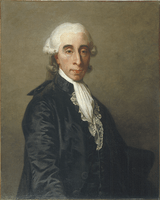
June
- June 3: The scientist Jean Sylvain Bailly became the leader of the Third Estate.
- June 10: The Third Estate decided to hold their own meeting. They invited the other groups to join.
- June 17: The Third Estate declared themselves the National Assembly. They said taxes only needed to be paid when the Assembly was meeting.
- June 19: Many clergy members joined the Third Estate's assembly.
- June 20: The king closed the Third Estate's meeting hall. So, the representatives met in an indoor tennis court. They swore not to stop until France had a new Constitution. This was the Tennis Court Oath.
- June 23: King Louis XVI told the Estates General to keep meeting separately. He left, but the Third Estate stayed. Their leader, Mirabeau, famously said they would only leave "at the point of a bayonet."
- June 27: Louis XVI changed his mind. He told the nobles and clergy to join the new Assembly. But he also ordered soldiers to Paris.
- June 30: A crowd freed soldiers who were jailed for attending political meetings.
July
- July 6: The National Assembly formed a committee to write a new Constitution.
- July 9: The National Assembly renamed itself the National Constituent Assembly.
July 14, 1789: The Storming of the Bastille
-
Storming of the Bastille (July 14, 1789)
- July 11: Louis XVI suddenly fired Necker. Parisians reacted by burning customs buildings and looting a monastery. There were clashes between the king's soldiers and angry crowds. Many French guards sided with the people.
- July 14: A large crowd attacked the Bastille. This old fortress held only a few prisoners but had a lot of gunpowder. The crowd wanted the gunpowder. After hours of fighting, the governor of the Bastille surrendered. He was then killed by the crowd.
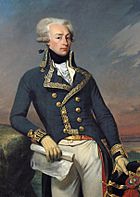
- July 15: Jean Sylvain Bailly became the mayor of Paris. Lafayette was named commander of the new National Guard.
- July 16: The king brought Necker back as finance minister. He also pulled royal troops out of Paris. The new Paris assembly voted to destroy the Bastille.
- July 17: The king visited Paris. He wore the tricolor symbol. Many nobles, sensing danger, started to leave France. They became known as émigrés.
- July 22: A mob killed two officials in Paris, accusing them of speculating on grain.
- July 21-August 1: Riots and peasant revolts broke out in many French cities.
- July 28: Jacques Pierre Brissot started publishing Le Patriote français, an important newspaper for the revolutionary movement.
August
- August 4: The king appointed a government with reform-minded ministers. The Assembly voted to end the special rights and feudal duties of the nobility.
- August 7: Jean-Paul Marat published a text saying the reforms were not enough. He demanded a more radical revolution. Marat became a voice for the most extreme revolutionaries, the sans-culottes.
- August 23: The Assembly declared freedom of religion.
- August 24: The Assembly declared freedom of speech.
August 27, 1789: Declaration of the Rights of Man
- August 27: The Assembly adopted the Declaration of the Rights of Man and of the Citizen. This important document was mostly written by Lafayette.
- August 28: The Assembly discussed whether the king should have the power to stop new laws.
- August 30: Camille Desmoulins organized a small uprising to stop the king's veto power. It failed.
- September 11: The National Assembly gave the king the power to temporarily stop laws for two legislative sessions.
- September 15: Desmoulins published a radical pamphlet supporting political violence.
- September 16: The first issue of Jean Paul Marat's newspaper, L'Ami du peuple, was published. It called for a radical social and political revolution.
- October 1: At a banquet in Versailles, the King's guards wore the white royal symbol. False news spread to Paris that they had disrespected the tricolor symbol, causing anger.
October 6, 1789: Women's March on Versailles
- October 5: Marat's newspaper called for a march on Versailles. Thousands of women marched, joined later by the Paris National Guard led by Lafayette.
- October 6: The crowd of women entered the Palace. They demanded that the King and his family return to Paris with them. The King agreed. The National Assembly also decided to move to Paris.
- October 10: The Assembly changed the king's title from "King of France and Navarre" to "King of the French." A doctor named Joseph-Ignace Guillotin suggested a new, more humane way of public execution, which later became known as the guillotine.
- October 12: Louis XVI secretly wrote to the King of Spain, complaining about how he was treated. The Count of Artois secretly asked the Austrian Emperor for military help in France.
- October 19: The National Assembly met for the first time in Paris, near Notre Dame Cathedral.
- November 2: The Assembly voted to take control of Church property.
- November 28: Desmoulins began publishing his weekly newspaper, attacking royalists and nobles.
- December 9: France was divided into departments, replacing the old provinces.
- December 19: The assignat was introduced. This was a new type of money based on the value of confiscated Church property.
- December 24: Protestants were allowed to hold public office, but Jews were still excluded.
1790: The Rise of Political Clubs
- January 18: Marat published a strong attack on finance minister Necker.
- January 22: Police tried to arrest Marat for his violent writings, but he escaped to London with help from the sans-culottes.
- February 13: The Assembly banned religious vows and closed contemplative religious orders.
- February 28: The Assembly ended the rule that army officers had to be nobles.
- March 8: The Assembly decided to keep slavery in French colonies.
- March 29: Pope Pius VI secretly condemned the Declaration of the Rights of Man and of the Citizen.
- April 5-June 10: There were many pro-Catholic and anti-revolutionary riots in French provinces.
- April 17: The Cordeliers club was founded. It became a strong voice for radical change.
- May 22: The Assembly decided that only it could declare war or peace, but the king still had to propose and approve it.
- June 19: The Assembly abolished titles, orders, and other special rights of the nobility.
- July 12: The Assembly passed a law about the status of French clergy. Clergymen lost their special status and had to swear loyalty to the government.
July 14, 1790: The Festival of Federation
- July 14: The Fête de la Fédération (Festival of Federation) was held in Paris. It celebrated the first anniversary of the Revolution. The king, queen, National Assembly, and a huge crowd attended. Lafayette and the king swore an oath to be loyal to the nation, the law, and the king. This event was the last time all groups in Paris were united during the Revolution.
- July 26: Marat demanded the immediate execution of hundreds of nobles to save the Revolution.
- July 31: The Assembly decided to take legal action against Marat and Desmoulins for calling for violence.
- August 16: The Assembly created justices of the peace to replace traditional noble courts.
- September 4: Necker, the finance minister, was dismissed. The National Assembly took control of public money.
- October 21: The Assembly decided that the tricolor flag would replace the white flag and fleur-de-lys as France's symbol.
- November 27: The Assembly ordered all clergy members to swear an oath to the Nation, the Law, and the King. Most French clergymen refused.
- December 3: Louis XVI secretly wrote to the King of Prussia, asking for military help from other European rulers to restore his power.
1791: The Royal Family Tries to Escape
- January 1: Mirabeau was elected President of the Assembly.
- February 19: The king's aunts left France for exile.
- February 28: Lafayette ordered the arrest of 400 armed nobles who gathered to protect the royal family. They were freed later.
- March 2: Traditional trade guilds were abolished.
- March 10: Pope Pius VI condemned the Civil Constitution of the Clergy.
- April 2: Mirabeau died.
- April 3: The Assembly suggested turning the new church of Sainte Geneviève into the Panthéon, a burial place for famous French citizens. Mirabeau was the first to be buried there.
- April 18: The National Guard stopped the royal family from leaving Paris for Easter.
- May 16: On a suggestion by Robespierre, the Assembly voted to prevent its current members from running for the next Assembly.
- June 14: The Chapelier Law was passed. It abolished corporations and banned labor unions and strikes.
June 20–21, 1791: The Royal Family Flees Paris
- June 20–21: The Flight to Varennes. The King, Queen, and their children secretly left the Tuileries Palace and tried to escape by carriage.
- June 21–22: The King was recognized and arrested at Varennes. The Assembly said he was taken against his will and sent people to bring him back to Paris.
- June 25: Louis XVI returned to Paris. The Assembly temporarily suspended his powers.
- July 5: Emperor Leopold II issued the Padua Circular. It asked European royal families to help Louis XVI.
- July 9: The Assembly ordered émigrés to return to France within two months or lose their property.
- July 15: The National Assembly declared the king could not be put on trial. Louis XVI's duties were suspended until a new Constitution was approved.
- July 16: More moderate members of the Jacobins club formed a new club called the Feuillants.
- July 17: A demonstration demanding the king's removal took place in the Champ de Mars. The National Guard fired on the crowd, killing about fifty people.
- August 14: A slave uprising began in Saint Domingue (Haiti).
- August 27: The Declaration of Pillnitz was issued by Austria and Prussia. It stated their wish to help the King of France. This was seen as a threat by other European powers.
- September 13–14: Louis XVI formally accepted the new Constitution.
- September 27: The Assembly declared all free men in France, regardless of color, were free. French Jews were granted citizenship. Slavery remained in the colonies.
- October 1: The new Legislative Assembly held its first meeting.
- November 9: Émigrés were again ordered to return to France or face property loss and death. King Louis XVI vetoed this.
- November 14: Jérôme Pétion de Villeneuve was elected mayor of Paris.
- December 3: The King secretly wrote to the King of Prussia, urging military intervention in France.
- December 14: Lafayette was given command of one of the new armies defending France's borders.
1792: War and the End of the Monarchy
-
The king is forced to wear a Phrygian cap and drink a toast to the Nation (June 20, 1792)
-
French victory over the Prussians at the Battle of Valmy (September 29, 1792)
- January–March: Food riots happened in Paris.
- February 7: Austria and Prussia signed a military agreement to invade France and protect the monarchy.
- February 9: The Assembly ordered the government to take the property of émigrés.
- April 20: The Assembly declared war on the King of Bohemia and Hungary (the Holy Roman Empire).
- April 25: La Marseillaise, a new war song, was sung for the first time.
- April 28: The war began. The French army invaded the Austrian Netherlands.
- May 27: The Assembly ordered the deportation of priests who had not sworn loyalty to the government.
- June 8: The Assembly ordered the creation of a 20,000-volunteer army near Paris.
- June 11: Louis XVI vetoed the laws about deporting priests and forming the new army.
- June 20: Demonstrators invaded the Tuileries Palace. King Louis XVI was forced to wear a red "liberty cap" and drink to the Nation.
- July 11: As the Austrian army moved towards Paris, the Assembly declared that the Nation was in danger.
- July 25: The Austrian commander warned that if the royal family was harmed, there would be "exemplary and eternally memorable revenge." This made Parisians furious at the king.
- July 30: Working-class citizens were allowed to join the National Guard. Volunteers from Marseille arrived in Paris, singing their new war song, the La Marseillaise.
- August 9: Georges Danton and his allies took over the Paris city government. They formed the Revolutionary Paris Commune.
August 10, 1792: Storming of the Tuileries; King Overthrown
- August 10: The Tuileries Palace was stormed. The National Guard and revolutionaries attacked the palace. The King and his family took refuge in the Legislative Assembly. The Swiss Guards defending the Palace were killed. The Legislative Assembly temporarily suspended the King's power. It ordered elections for a new government, the Convention.
- August 11: Danton was named Minister of Justice. Municipalities could arrest suspected enemies of the Revolution. Royalist newspapers were banned.
- August 13: The royal family was imprisoned in the Temple.
- August 17: A Revolutionary Tribunal was created, and a National Convention was called to replace the Assembly.
- August 19: Lafayette left his army and went into exile. The Austrian and Prussian armies, with French émigrés, crossed into France.
- August 22: The Paris Commune ordered people to be addressed as "Citizen" instead of "Monsieur" or "Madame."
- September 2: Verdun surrendered to the Austrian and Prussian troops.
September 2–7, 1792: Massacres in Paris Prisons
- September 2–7: After the news of Verdun's surrender, the Commune ordered massacres of prisoners in Paris prisons. Between 1400 and 2000 prisoners were killed. Most were common criminals, but some were priests and political prisoners.
- September 19: The Louvre Museum was created, displaying art from royal collections.
- September 20: The Assembly passed a new law allowing civil marriage and divorce.
September 20, 1792: French Victory at Valmy; Convention Begins
- September 20: The French army defeated the Prussians at the Battle of Valmy. The Prussians retreated.
- September 20: The newly elected National Convention held its first meeting.
- September 22: The Convention declared the end of royalty and established the First French Republic.
- September 29: French troops occupied Nice.
- October 27: The French army invaded the Austrian Netherlands (Belgium).
- November 19: The Convention claimed the right to intervene in any country where people wanted to gain freedom.
- November 20: Secret letters from Louis XVI to foreign monarchs were found in the Tuileries Palace.
- December 3: Robespierre, a leader of the Jacobins, demanded the king be put to death.
- December 6: The Convention ruled that each deputy must publicly declare their vote on the king's death penalty.
December 10, 1792-January 21, 1793: Trial and Execution of Louis XVI
- December 10: The trial of Louis XVI began before the Convention.
- December 11: Louis XVI appeared before the Convention.
- December 26: The king's lawyer presented his defense.
- January 15: The Convention declared Louis XVI guilty of conspiring against public liberty. The vote was 707 to zero.
- January 17: In a long vote, 361 deputies voted for the death penalty, and 360 voted against it. The Convention rejected a final appeal.
- January 21: Louis XVI was beheaded at 10:22 AM on the Place de la Révolution. His final words were drowned out by a drum roll.
1793: France at War; Jacobins Take Power; The Terror Begins
- January 21: Louis XVI, at age 38, was beheaded by guillotine on the Place de la Révolution.
- February 1: The Convention declared war against England and the Dutch Republic.
- March 7: The Convention declared war against Spain.
Uprising in the Vendée
- March 7: The War in the Vendée began. An armed uprising against the Convention started in the Vendée region. People were especially against being forced into the army.
- March 10: The Revolutionary Tribunal was established in Paris. It was a special court for political crimes.
- March 19: The Convention decreed the death penalty for anyone taking part in the Vendée uprising.
- March 21: Revolutionary Surveillance Committees were set up in all towns.
- April 1: A general named Dumouriez arrested Convention officials and handed them to the Austrians.
- April 3: The Convention declared Dumouriez an outlaw.
- April 5: Jean Paul Marat was elected head of the Jacobin Club.
April 6–May 30, 1793: Committee of Public Safety Takes Control
- April 6: The Committee of Public Safety was created by the Convention. It became the main executive body of the government.
- April 12: The Convention voted to arrest Marat for inciting violence in his newspaper. Marat went into hiding.
- April 24: Marat was brought before the Revolutionary Tribunal and found innocent. His release led to big celebrations by his supporters.
- May 4: The Convention set a maximum price for grain.
- May 26: Robespierre and Marat called for an uprising against the Convention. The Paris Commune began preparing to seize power.
- May 30: Leaders in Lyon rebelled against the Convention.
May 31-June 2, 1793: The Jacobin Coup d'État
- May 31: An armed crowd of sans-culottes stormed the Convention hall. They demanded it disband, but the deputies resisted.
- June 2: The sans-culottes and Paris Commune soldiers occupied the Convention hall. They forced it to vote for the arrest of 29 moderate deputies, known as Girondins.
- June 6: Revolts against the Jacobin takeover began in many cities like Marseille and Toulouse.
- June 10: Jacobins gained control of the Committee of Public Safety.
- June 24: A new Constitution was approved by the National Convention.
- July 3: The 8-year-old Louis XVII, the king's son, was taken from Marie Antoinette and given to a cobbler.
July 13, 1793: Assassination of Jean-Paul Marat
- July 13: Charlotte Corday assassinated Jean-Paul Marat in his bath. She said, "I killed one man to save a hundred thousand."
- July 17: Charlotte Corday was tried and guillotined for murdering Marat.
- July 27: Robespierre was elected to the Committee of Public Safety.
- August 1: The Convention declared a "scorched earth" policy against rebellious regions.
- August 1: The Convention adopted the principles of the metric system.
- August 1: A mob desecrated the tombs of French Kings at the Basilica of Saint-Denis.
- August 2: Marie-Antoinette was moved to the Conciergerie prison.
- August 23: The Levée en masse was voted by the Convention. All unmarried men aged 18 to 25 had to serve in the army.
- August 25: Convention soldiers captured Marseille.
- August 27: Anti-Convention leaders in Toulon invited the British fleet to occupy the city.
September 17, 1793: The Reign of Terror Begins
- September 17: The Convention adopted a new Law of Suspects. This law allowed for the quick arrest and trial of anyone suspected of opposing the Revolution. This marked the start of the Reign of Terror.
- September 29: The Convention passed the General Maximum. This law set maximum prices for many goods and services, as well as maximum salaries.
- October 3: The Convention ordered Marie-Antoinette to be tried by the Revolutionary Tribunal.
- October 5: To break with the past, the Convention adopted the new Republican Calendar. Year I began on September 22, 1792.
- October 9: Lyon was recaptured by the Convention's army.
- October 10: The Convention declared that "The government of France is revolutionary until the peace." This put the new Constitution on hold.
- October 12: The Convention ordered the city of Lyon to be destroyed for its rebellion. It was renamed Ville-Affranchie.
- October 16: The Convention's army defeated the Austrian Army at the Battle of Wattignies.
October 16, 1793: The Execution of Marie-Antoinette
- October 16: Marie-Antoinette was found guilty and guillotined on the Place de la Revolution.
- October 30: The Revolutionary Tribunal sentenced 21 Girondins deputies to death.
- October 31: The 21 Girondins deputies were guillotined.
- November 3: Olympe de Gouges, a champion of women's rights, was guillotined.
- November 7: Philippe Égalité was guillotined.
- November 8: Madame Roland was guillotined. She famously cried, "Liberty, what crimes are committed in your name!"
- November 10: The Cathedral of Notre Dame was rededicated as a Temple of Reason.
- November 12: The astronomer and former mayor of Paris, Jean Sylvain Bailly, was executed.
- November 23: The Paris Commune ordered all churches and places of worship in Paris to close.
- November 25: The Convention voted to move Mirabeau's remains from the Panthéon and replace them with Marat's.
- December 19: The British withdrew from Toulon after a successful military operation led by a young artillery officer, Napoléon Bonaparte.
- December 23: The last Vendéen army was destroyed. Six thousand prisoners were executed.
1794: The Height of the Terror and Robespierre's Fall
- February 4: The Convention voted to abolish slavery in French colonies.
- February 5: Robespierre explained the need for the Terror: "The foundations of a popular government in a revolution are virtue and terror; terror without virtue is disastrous; and virtue without terror is powerless."
- February 6: Napoleon Bonaparte was promoted to general.
- March 13: Saint-Just, President of the Convention, spoke about a plot against liberty. Hébert and other Cordeliers were arrested.
- March 24: Hébert and other Cordeliers leaders were condemned to death and guillotined.
March 30, 1794: Danton and Desmoulins Arrested
- March 30: Danton, Camille Desmoulins, and their supporters were arrested.
- April 2: Danton's trial began before the Revolutionary Tribunal.
- April 5: Danton and Desmoulins were convicted and guillotined the same day.
- April 14: At Robespierre's request, the Convention ordered the transfer of Jean-Jacques Rousseau's ashes to the Panthéon.
- May 7: Robespierre asked the Convention to declare that "the French people recognize the existence of a Supreme Being and the immortality of the soul."
- May 8: The chemist Antoine Lavoisier and many others were guillotined.
- May 10: Madame Élisabeth, the sister of Louis XVI, was executed.
- June 4: Robespierre was unanimously elected president of the Convention.
June 8, 1794: Festival of the Supreme Being; Terror Speeds Up
-
The poet André Chenier and other victims of the Terror await judgement at the Conciergerie (July 25, 1794)
- June 8: The Festival of the Supreme Being was held, led by Robespierre. Some deputies were annoyed by his behavior.
- June 10: The Law of 22 Prairial was passed. It sped up trials and made it easier to get death sentences. From June 11 to July 27, 1,376 prisoners were sentenced to death.
- June 26: French forces defeated the Austrians at the Battle of Fleurus.
- June 29: There was a dispute within the Committee of Public Safety. Some members accused Robespierre of acting like a dictator. He left the Committee.
- July 25: The poet André Chénier was guillotined.
July 26–28, 1794: Robespierre's Arrest and Execution; End of the Terror
- July 26: Robespierre gave a strong speech at the Convention. He demanded the arrest of "traitors" in the Committees, but didn't name them.
- July 27: The Convention voted to arrest Robespierre, his younger brother, Saint-Just, and others. They were taken to prison but refused entry. Soldiers loyal to the Convention took control of the city hall.
- July 28: Robespierre was wounded in the jaw. He and his supporters, including his brother and Saint-Just, were guillotined. No trial was needed as they were declared outlaws.
- August 5: Prisoners arrested under the Law of Suspects were released.
- August 9: Napoléon Bonaparte was arrested but released later.
- August 29: The first anti-Jacobin demonstration in Paris took place.
- August 30: All French territory was freed from foreign occupation.
- September 13: The term "vandalism" was coined to describe the destruction of religious monuments.
- September 18: The Convention stopped paying official priests and maintaining church properties.
- September 21: Marat's remains were placed in the Panthéon.
- November 12: The Convention ordered the Jacobin Club to suspend its meetings.
- December 16: Carrier was convicted and executed for ordering mass executions in the Vendée.
- December 24: The Convention repealed the law setting maximum prices for food.
1795: The Directory Replaces the Convention
- January 19: The French army captured Amsterdam.
- February 8: The remains of Marat and other extreme Jacobins were removed from the Panthéon.
- February 14: Several former Jacobin leaders were killed in Lyon. This began the First White Terror.
- February 21: The Convention declared freedom of religion and the separation of church and state.
- March 2: The Convention ordered the arrest of Jacobins who had led the downfall of Robespierre.
- March 17: Food riots occurred in Paris.
- March 19: Grain supplies in Paris ran out. The assignat currency lost most of its value.
- April 1: Sans-culottes invaded the Convention, but the National Guard cleared the hall. Paris was declared under siege.
- April 5: A peace agreement was signed between Prussia and France. Prussia accepted France's control of the left bank of the Rhine.
- May 7: The former chief prosecutor, Fouquier-Tinville, and the jurors of the Revolutionary Tribunal were guillotined.
May 20–24, 1795: Last Paris Uprising by Jacobins
- May 20: An armed uprising against the Convention by Jacobins and sans-culottes occurred. They invaded the Convention hall. The army quickly responded and cleared the hall.
- May 24: The army secured the area and arrested those involved in the uprising.
- May 31: The Convention abolished the Revolutionary Tribunal.
- June 8: The 10-year-old Louis XVII died in prison. His uncle in exile became Louis XVIII.
June 25-July 27, 1795: Uprisings in Vendée and Royalist Invasion
- June 23: Rebels in the Vendée resumed their rebellion.
- June 26: A royalist army landed in Brittany with British support.
- June 30: The royalist army in Brittany was defeated by General Hoche.
- July 21: The royalist army surrendered. 748 émigrés were executed.
- July 22: A peace treaty was signed between Spain and France. France gained territory. France was now only at war with Austria and England.
- August 15: The Franc became the new French currency.
August 22-September 23, 1795: New Constitution and Directory
- August 22: The Constitution of the Year III, a new Constitution, was adopted. It created a two-house parliament and an executive body of five members called the Directory.
- September 23: The new Constitution was approved by a national vote and took effect.
October 5, 1795: Bonaparte Stops Royalist Rebellion
- October 5: An armed royalist uprising threatened the Convention. General Bonaparte led the army against the uprising. He used cannons to break up the rebel gathering.
- October 12: Elections began for the new legislative chambers.
- October 26: Bonaparte was named commander-in-chief of the Army of the Interior.
- October 31: The first Directory was elected. Its members included Paul Barras and Lazare Carnot.
- December 26: The daughter of Louis XVI and Marie-Antoinette was exchanged for republican prisoners held in Austria.
1796: Napoleon's Italian Campaign; Royalists Defeated
-
General Bonaparte defeats the Austrians at the Battle of Lodi (May 10, 1796)
-
Failed uprising at the Grenelle military camp by Montagnards and followers of Babeuf (9 September 1796)
-
General Bonaparte leads his soldiers across a bridge at the Battle of Arcole (November 15–17, 1796)
- February 19: The government stopped issuing assignats as they had lost most of their value.
- February 23: The Vendéen rebel leader Nicolas Stofflet was captured and executed.
- February 28: General Bonaparte closed an extreme leftist club in Paris.
- March 2: The Directory named General Bonaparte commander of the Army of Italy.
- March 9: Napoléon Bonaparte married Joséphine de Beauharnais.
- March 23: François de Charette, the last leader of the royalist rebellion in Vendée, was captured and executed.
- March 30: François-Noël Babeuf, an ultra-leftist leader, formed a movement to overthrow the government.
- April 10: Bonaparte began his Italian campaign with victories over the Austrians and Sardinians.
- May 10: Bonaparte defeated the Austrians at the Battle of Lodi.
- May 15: A treaty was signed with the King of Sardinia, who gave Savoy and Nice to France.
- June 4: Bonaparte began the siege of Mantua, the last Italian city held by Austria.
- August 5: Bonaparte defeated the Austrians at the Battle of Castiglione.
- August 19: A treaty of alliance was signed between France and Spain.
- September 9: A failed uprising by followers of Babeuf occurred in Paris.
- October 5: Spain, now allied with France, declared war on Britain.
- November 15–17: Bonaparte won a decisive victory over the Austrians at the Battle of Arcole.
- December 15–17: A French fleet carrying an army to invade Ireland departed, but storms forced it to return.
1797: Bonaparte Dominates Italy; Republican Coup in Paris
-
General Bonaparte by David (1797)
-
Bonaparte defeats Austrians at the Battle of Rivoli (January 14, 1797 )
-
Republican coup d'état of September 4, 1797. Arrest of General Pichegru and other royalist leaders of the legislature by the army at the Tuileries Palace.
-
General Pichegru, leader of the royalist party
- January 14: Bonaparte defeated the Austrians at the Battle of Rivoli.
- February 2: The last Austrian forces in Italy surrendered to Bonaparte.
- February 19: Pope Pius VI gave up territory to the new Cispadane Republic.
- February 20: The trial of Babeuf and his followers began.
- March 2: The Directory allowed French warships to capture U.S. ships.
- April 7: After Bonaparte's victories, the Austrians agreed to negotiate.
- April 18: A preliminary peace treaty was signed with Austria. Austria gave up its claim to the Austrian Netherlands (Belgium).
- April 18: Partial elections for the legislature resulted in many royalists being elected.
- May 26: Babeuf and a supporter were sentenced to death and executed.
- June 14: Bonaparte installed a new government in Genoa, aiming to create a new Ligurian Republic.
- June 24: Director Paul Barras sought military support for a coup against the royalist majority in the legislature.
- July 9: The French supported the formation of the Cisalpine Republic in northern Italy.
- July 27: Bonaparte sent General Augereau to Paris to support a coup against the royalists.
September 4, 1797: A Republican Coup d'État
- September 4: The coup d'état of 18 Fructidor occurred. General Augereau arrested leading royalist deputies.
- September 5: The Directory forced the Councils to annul the elections of 200 royalist deputies and deport 65 royalist leaders and journalists.
- September 17: A peace treaty was signed between Austria and France. Austria gained Venice, while France received Belgium and territory along the Rhine River.
- December 28: Anti-French riots in Rome led to the murder of a French general. The Directory rejected the Pope's apologies.
1798: New Republics; Bonaparte Invades Egypt
-
The French Army under General Berthier enters Rome (February 10, 1798)
-
General Bonaparte at the Battle of the Pyramids (July 21, 1798)
- January 11: The Directory ordered General Berthier to march on Rome.
- February 15: General Berthier proclaimed a new Roman Republic under French protection.
- February 23: Bonaparte recommended invading Egypt instead of England.
- March 5: The Directory approved Bonaparte's plan to invade Egypt.
- March 22: A new Helvetic Republic was proclaimed in Switzerland, supported by France.
- May 11: The Council of Ancients and the Council of Five Hundred invalidated the election of 106 Jacobin deputies.
- May 19: Bonaparte and his army set sail from Toulon for Egypt.
- June 9–11: Bonaparte invaded and captured Malta.
- July 1–2: Bonaparte landed in Egypt and captured Alexandria.
- July 21: Bonaparte defeated the Mameluks at the Battle of the Pyramids.
- July 24: Bonaparte and his army entered Cairo.
- August 1: Admiral Nelson and the British fleet destroyed the French fleet at the Battle of the Nile. This trapped Bonaparte in Egypt.
- September 5: The Jourdan law required all French men aged 20 to 25 to perform military service.
- October 21: The people of Cairo rebelled against French occupation. Bonaparte suppressed the rebellion.
- November 27: The army of the King of Naples captured Rome.
- December 6: The French army defeated the army of the King of Naples.
- December 14: The French army recaptured Rome.
- December 29: An alliance (Second Coalition) was signed between Russia, Britain, and the Kingdoms of Naples and Sicily against France.
1799: France at War; Bonaparte Returns; The Consulate Takes Power; Revolution Ends
-
Pope Pius VI was moved to France as a prisoner of the Directory (April 10, 1799)
-
General André Masséna forced the Russians out of Switzerland (September 26, 1799)
- January 23: The French army occupied Naples.
- February 20: Bonaparte marched his army from Cairo towards Syria.
- March 3: French troops in Corfu surrendered after a long siege.
- March 7: Bonaparte captured Jaffa in Palestine. Some of his soldiers became infected with the plague.
- March 12: The Directory declared war on Austria.
- March 19: Bonaparte began the siege of Saint-Jean-d'Acre in Palestine.
- March 25: The French army was defeated by Austrians at the Battle of Stockach.
- April 10: Pope Pius VI, a prisoner of the French, was transferred to France.
- April 14: The Austrian and Russian armies joined forces in Italy.
- April 16: Bonaparte defeated the Ottoman army at the Battle of Mount Tabor.
- April 27: The Russian-Austrian army defeated French forces at the Battle of Cassano.
- May 17: Bonaparte lifted the siege of Saint-Jean-d'Acre.
- May 16: Emmanuel Joseph Sieyès joined the Directory.
- June 14: Bonaparte returned to Cairo.
Conflicts between the Directory and the Legislature (June 1799)
-
General Jourdan, a leader of the Jacobins in the army
-
The French army under General Masséna wins a decisive victory over the Austrians and Russians at the Second Battle of Zürich (September 24–25, 1799)
-
The British Admiral Sir Sidney Smith sends Bonaparte French newspapers, letting him know of events in Paris. Bonaparte promptly leaves his army in Egypt and sails for France. (August 23, 1799)
- June 16: A serious struggle began between the left-wing members of the Council of Five Hundred and the Directory.
- June 18–19: Two royalist members of the Directory were forced to resign.
- June 19: A French army was defeated by the Russians at the Battle of the Trebia.
- July 12: The Council of Five Hundred voted a new law on hostages.
- July 17: An Ottoman army landed in Egypt.
- July 25: Bonaparte defeated the Ottoman army at the Battle of Abukir.
- August 13: Sieyès ordered the closing of the new Jacobin Club in Paris.
- August 15: The French Army of Italy was defeated at the Battle of Novi.
- August 23: Bonaparte had not received news from France for six months. The British admiral Sir Sidney Smith sent him French newspapers. After reading them, Bonaparte left his army in Egypt and sailed for France.
- August 29: Pope Pius VI died as a French prisoner.
- September 25–26: General Masséna defeated the Russian-Austrian army at the Second Battle of Zurich.
- October 6: A French-Dutch army defeated a Russian-British force. The British and Russians withdrew from the Netherlands.
Bonaparte Returns to France (October 9, 1799)
- October 9: Bonaparte landed at Saint-Raphaël.
- October 16: Bonaparte arrived in Paris to public celebrations.
- October 23: Lucien Bonaparte, Napoleon's younger brother, was elected President of the Council of Five Hundred.
- October 23–29: Royalist forces briefly captured several cities in western France but were quickly driven out.
- November 1: Bonaparte met with Sieyès. They agreed to a plan to replace the Directory.
- November 3: Bonaparte met with Joseph Fouché, the Minister of Police, who agreed not to interfere with the plan.
The Coup d'État of November 9–10
-
Emmanuel Joseph Sieyès proposed the coup d'état, but was left out of the final government
-
Lucien Bonaparte, 24 years old, was elected President of the Council of Five Hundred, and aided Bonaparte's coup d'état
-
Joseph Fouché, Minister of Police, assured that the police would not interfere in Bonaparte's seizure of power
- November 9: The coup d'état of 18 Brumaire began. French troops loyal to Bonaparte occupied key points in Paris. Lucien Bonaparte, president of the Council of Five Hundred, warned deputies of a "terrorist" plot. He asked for meetings to be moved to the château of Saint-Cloud for safety. Bonaparte was named Commander-in-chief of the army in Paris. Two members of the Directory resigned. A third was convinced to resign. The two Jacobin directors were arrested. By the end of the day, Paris was under Bonaparte's control.
- November 10: The members of the two Councils were moved to Saint-Cloud. Bonaparte spoke to the Council of the Ancients, explaining the need for a new government. They agreed. Bonaparte then spoke to the Council of Five Hundred. Jacobin members protested loudly and insulted him. Lucien Bonaparte told waiting soldiers that deputies tried to assassinate Bonaparte. The soldiers then entered the meeting hall and forced the deputies out. With the opposition gone, two commissions named Bonaparte, Sieyès, and Duclos as provisional consuls of a new government.
- November 11–22: Bonaparte and the other two Provisional Consuls formed a new government. Key ministers were appointed.
- December 24: The Councils, now controlled by Bonaparte, adopted the Constitution of the Year VIII. The new Consulate was formally established. Bonaparte became First Consul. This date is often seen as the end of the French Revolution.
Images for kids
-
Louis XVI in 1777
-
Jacques Necker, minister of finance 1788-90
-
The Tennis Court Oath (June 20, 1789), by Couder
-
Emmanuel Joseph Sieyès, who proposed that the Third Estate become the National Assembly (June 10, 1789)
-
Jean Sylvain Bailly, leader of the Third Estate (1789)
-
Storming of the Bastille (July 14, 1789)
-
Lafayette in 1791
-
The king is forced to wear a Phrygian cap and drink a toast to the Nation (June 20, 1792)
-
French victory over the Prussians at the Battle of Valmy (September 29, 1792)
-
The poet André Chenier and other victims of the Terror await judgement at the Conciergerie (July 25, 1794)
-
General Bonaparte defeats the Austrians at the Battle of Lodi (May 10, 1796)
-
Failed uprising at the Grenelle military camp by Montagnards and followers of Babeuf (9 September 1796)
-
General Bonaparte leads his soldiers across a bridge at the Battle of Arcole (November 15–17, 1796)
-
General Bonaparte by David (1797)
-
Bonaparte defeats Austrians at the Battle of Rivoli (January 14, 1797 )
-
Republican coup d'état of September 4, 1797. Arrest of General Pichegru and other royalist leaders of the legislature by the army at the Tuileries Palace.
-
General Pichegru, leader of the royalist party
-
The French Army under General Berthier enters Rome (February 10, 1798)
-
General Bonaparte at the Battle of the Pyramids (July 21, 1798)
-
Pope Pius VI was moved to France as a prisoner of the Directory (April 10, 1799)
-
General André Masséna forced the Russians out of Switzerland (September 26, 1799)
-
General Jourdan, leader of the Jacobins in the army
-
The French army under General Masséna wins a decisive victory over the Austrians and Russians at the Second Battle of Zürich (September 24–25, 1799)
-
The British Admiral Sir Sidney Smith sends Bonaparte a packet of French newspapers, letting him know of events in Paris. Bonaparte promptly leaves his army in Egypt and sails for France. (August 23, 1799)
-
Emmanuel Joseph Sieyès proposed the coup d'état, but was left out of the final government
-
Lucien Bonaparte, 24 years old, was elected President of the Council of Five Hundred, and aided Bonaparte's coup d'état
-
Joseph Fouché, Minister of Police, assured that the police would not interfere in Bonaparte's seizure of power
See also
 In Spanish: Anexo:Cronología de la Revolución francesa para niños
In Spanish: Anexo:Cronología de la Revolución francesa para niños


